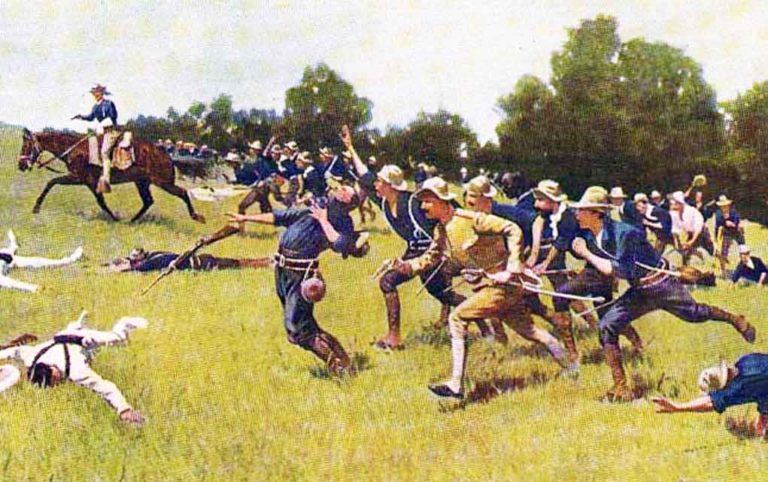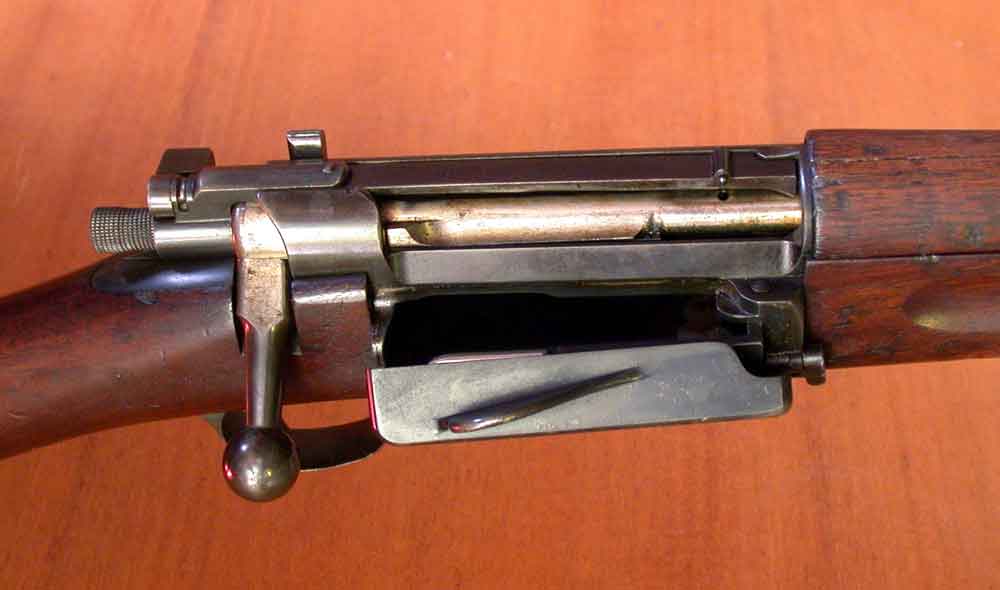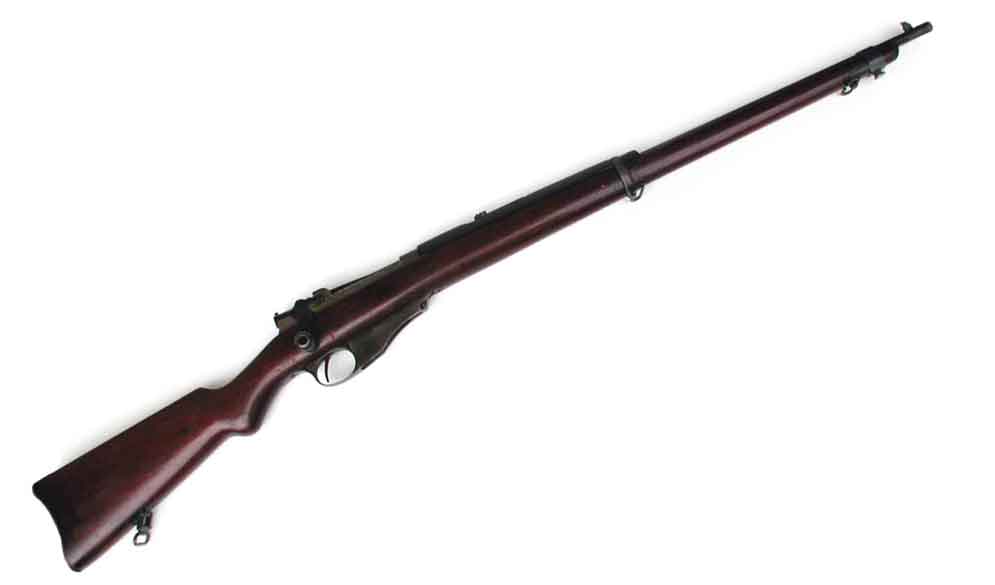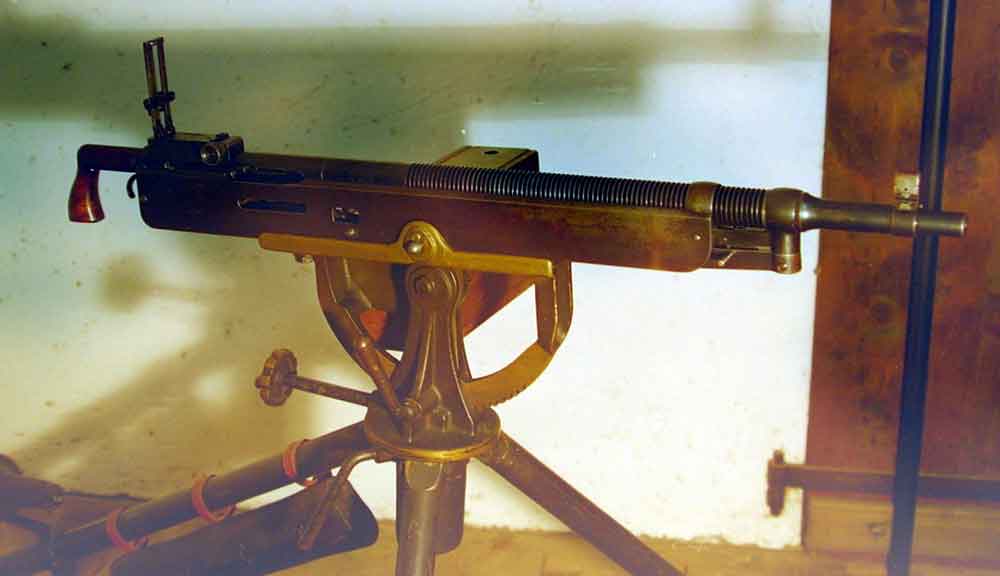
The Spanish-American War was among our country's briefest conflicts, yet it marked the introduction of a number of important advancements when it comes to firearms designs.
What were the long guns that stormed the Cuban beaches and charged San Juan Hill?
- Springfield Model 1892 & 1896 Krag–Jørgensen
- Springfield Model 1873
- Model 1895 Lee Navy
- Spanish M1893
- Colt/Browning Model 1895 Machine Gun
- Gatling Gun
The Spanish-American War was among the shortest conflicts America has fought. But despite its brevity, it was weighty, and not only in determining the United States' place in the world. But also, because it marked the introduction of a number of new firearms concepts and technologies, many of which form the bedrock of today’s guns.
The conflict saw the American military’s first widespread use of smokeless powder. It was among the country’s first conflicts in which it utilized the modern machine gun. And it, on the Spanish side, featured gun designs that still to this day define modern rifles. So gird your loins and get set to charge like a Rough Rider into the six long guns (and a couple machine guns) you need to know from the Spanish-American War.
Springfield Model 1892 & 1896 Krag–Jørgensen

In perfect 20/20 historical hindsight, the Krag–Jørgensen might seem like a lemon. After all, the U.S. Army was quick to replace it after the Spanish and Philippine wars with the iconic Springfield M1903. But this view is a bit of a bum wrap.
The Krag–Jørgensen beat out a slew of other designs to become the Army’s service rifle in the early 1890s. And it was the first truly modern rifle — by today’s definition — the branch adopted.
Consider, it was the first U.S. Army service rifle to fire small-caliber smokeless cartridges, the first to utilize a bolt-action, and the first rifle widely used to feed off a magazine. And by all accounts, the U.S. variants used in the Spanish-American War — mainly the Springfield Model 1892 and 1896, but there were some 1898s — performed admirably. They were the backbone of the Yankees thoroughly blackening a European empire’s eye in the span of weeks.
Where the Norwegian-designed rifle comes up wanting is in comparison to the service rifle it was up against — the Spanish M1893, better known as the Spanish Mauser. The American’s .30-caliber had two main deficiencies compared to the M1893. Its unique horizontally accessed magazine could not utilize stripper clips, reducing its rate of fire. And the Krag–Jørgensen had a much weaker action, with a single locking lug, and thus fired the much weaker .30-40 Krag.
Despite these shortcomings, the Krag–Jørgensen rifles and carbines still left their marks. And they truly helped usher in the modern era of American military power.
Springfield Model 1873

The venerable “Trapdoor Springfield” had served the U.S. Military well in the Plains Wars and beyond, but was well past its prime by the time America sailed for Cuba. Nonetheless, the single-shot rifles still found their way into U.S. soldiers' hands.
It was a matter of necessity, given there were not enough Krag–Jørgensens to go around, yet ample Trapdoors — from the original Model 1873 clear through to the Model 1888.
Typically, volunteer units ended up armed with the antiquated rifles, with a notable exception — the 1st United States Volunteer Cavalry, also know as the Rough Riders. Most likely, the second in command of the unit — Theodore Roosevelt — had the political clout to ensure his men were armed with the modern Krag–Jørgensen bolt-actions.
The Model 1873 in all its iterations packed a punch and a half, firing the massive .45-70 Government round. Given it was a favorite of Buffalo hunters, it was more than enough to handle man-sized targets.
Aside from an abysmal rate of fire for its time, the prairie cannon had one other huge chink in its armor — it was a black powder rifle. In turn, every shot gave a soldier’s position away, due to a large puff of smoke emitted from the muzzle. Little more was needed for the Spanish troops to rain hell down upon a soldier armed with a Trapdoor.
Model 1895 Lee Navy

The Krag–Jørgensen may have been the U.S. Army’s first small-bore rifle, but it was not the first one adopted by America’s Armed Services. That distinction goes to this 6mm gem from Winchester.
Designed by James Paris Lee — of Lee-Metford and Lee-Enfield fame — the Model 1895 Lee Navy is easily the Spanish-American War’s most unique rifle. What makes it so special is its action, which at first blush appears to be a straight pull, but is actually a camming action. This single feature made the 1895 Lee Navy a lightning-fast rifle to operate, though it did take some drilling to master the mechanism to its full extent.
The rifle’s cartridge, the 6mm Lee Navy, was the smallest caliber used by the U.S. Military until the adoption of the 5.56 NATO. And it produced some pretty impressive velocities for the era, capable of pushing a 112-grain bullet more than 2,500 fps.
The U.S. Marines put this ballistic potential to good use in the battles of Camp McCalla and Cuzco Well, in some cases engaging Spanish troops 1,200 yards out. The 1895 Lee Navy saw extensive use in the Pacific during the conflict, and again in the Philippine-American War.
While the rifle performed well and offered some advantages over other service rifles of the time, it had a short-lived service life. By the 1900s, the Navy looked to move to the Krag–Jørgensen to standardize similar to the Army.
Spanish M1893

In short, the Spanish Mauser was a wicked rifle. On top of that, it was arguably the most influential weapon of the Spanish-American War, in terms of design and effectiveness.
To the latter point, the battles of San Juan and Kettle Hills provide a good example. While the Americans won the battle, they did so by sustaining massive casualties at the hands of 700 Spanish defenders. In all, 21 percent, or 1,400 U.S. soldiers of the 6,600 who fought were casualties in the attack.
There were a number of factors that made the Model 1893 so effective, but perhaps the most important was one of Paul Mauser’s greatest contributions to rifle design and another he helped to popularize — a box magazine that staggered the cartridges and the stripper clip. The easily loaded magazine and a way to quickly load it meant the Spanish could throw a nearly uninterrupted wall of copper-jacketed lead at the Americans.
And what they fired was an absolute classic and deadly cartridge — the 7x57mm Mauser. The low-recoil round was flat shooting and accurate, making it easy to fire quickly, with great effect.
The Americans with their Krag–Jørgensen rifles were outgunned in every sense against the Spanish Mauser. It’s no wonder the U.S. Military was was so quick to go back to the drawing board when it came to its service rifle. It’s also no wonder why, when it adopted its new one — the Springfield M1903 — it drew so heavily off Mauser’s designs.
Colt/Browning Model 1895 Machine Gun

John Browning’s first machine gun had mixed results in the Spanish-American War.
Chambered in 6mm Lee Navy, the gas-operated, belt-fed M1895 did a dynamite job supporting U.S. Marines in the Invasion of Guantanamo Bay. But a pair of 7x57mm Mauser models utilized by the Rough Riders didn’t fair quite as well. Privately purchased by Sgt. William Tiffany (son of famous jeweler Louis Tiffany), the machine guns caused some Spanish casualties, but by most accounts were undependable.
Despite this somewhat spotty record, the M1895 ushered in a new age of weaponry for the U.S. Military. Lightweight and able to pitch more than 400 rounds per minute, the machine gun gave soldiers the ability to lay down a high volume of fire nearly anywhere needed. Before, it was an arduous task, given the only gun with a comparable rate of fire — the Gatling gun — required an artillery carriage to move about.
The M1895 had a unique design, drawing heavily from Browning’s background designing lever-action rifles. This is most obvious in the machine gun’s swinging arm, which earned the firearm the nickname the “Potato Digger.” Gas was diverted directly from the barrel to the piston that actuated the swinging arm, which then cycled the rifle much like a lever-action. This lead to one of the M1895’s greatest disadvantages, where it could be set up, since the arm required room to operate.
It might not have been perfect, but it certainly helped pushed machine gun designs in a new direction. As time wore on, the light, air-cooled machine gun continued to grow in military importance.
Gatling Gun

The Spanish-American War was the last great conflict the Gatling gun would take part in. Nearing a quarter-century of service, the heavy, hand-cranked beast’s days were numbered. Nimbler, more compact and faster-firing machine guns were beginning to dot the globe’s conflicts — including the one in Cuba and the Pacific. But even with its demise well within sight, the Gatling went out with a bang, acquitting itself admirably in the war, particularly at San Juan and Kettle hills.
Three Gatlings — 10-barrel, chambered in .30-40 Govt. — mounted on swivels provided much-needed support on the troops advance up the hills. In all, the guns fired a total of 18,000 rounds in a little over 8 minutes, pining down and devastating the Spanish troops. The damaged reeked by the Gatlings earned the highest praises of the soldiers who fought the battle, with Theodore Roosevelt stating he’d never want to fight another battle without one.

Next Step: Get your FREE Printable Target Pack
Enhance your shooting precision with our 62 MOA Targets, perfect for rifles and handguns. Crafted in collaboration with Storm Tactical for accuracy and versatility.
Subscribe to the Gun Digest email newsletter and get your downloadable target pack sent straight to your inbox. Stay updated with the latest firearms info in the industry.

![Best Concealed Carry Guns In 2025 [Field Tested] Wilson Combat EDC X9S 1](https://gundigest.com/wp-content/uploads/Wilson-Combat-EDC-X9S-1-324x160.jpg)


![Best 9mm Carbine: Affordable PCCs [Tested] Ruger Carbine Shooting](https://gundigest.com/wp-content/uploads/Ruger-Carbine-Shooting-100x70.jpg)
![Best AR-15: Top Options Available Today [Field Tested] Harrington and Richardson PSA XM177E2 feature](https://gundigest.com/wp-content/uploads/Harrington-and-Richardson-PSA-XM177E2-feature-100x70.jpg)
